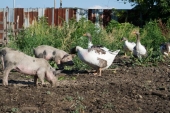I have sown two types of corn (maize) this year, they are still in pots waiting to be planted in the garden. They are one variety of sweet corn, and one popcorn maize.
I live in Norway, northern Europe, in a coastal climate, and corn is probably on the border of being possible here. Other places in Norway, with a more inland and warmer climate, grow sweet corn, however, and some places also grow maize for animal feed (silage). I have also grown a few cobs in my climate earlier. It should be possible, if the summer is warm and the seeds are sown early.
I am sorry if I mix up and use the words "maize" or "corn" incorrectly, I don't know the distinction, if any.
I have read that corn can answer rapidly to selection breeding, and would like to harvest seeds to get better adapted plants in the future.
Should my two varieties this year for this reason be grown far apart?
Another, almost unrelated question: I visited Guatemala in 2002, and brought home some maize seeds, red, black and white. These will be flour maize, I believe. I had forgotten about them, and found them again and tried to sprout them this spring, with no success. I have read later that maize seeds can be viable for 3-4-5 years, so my seeds are probably way too old. But can there be any tricks to see if maybe one in 1000 may still germinate? Red maize would be nice to grow. The seeds have been stored dry and not too warm.





